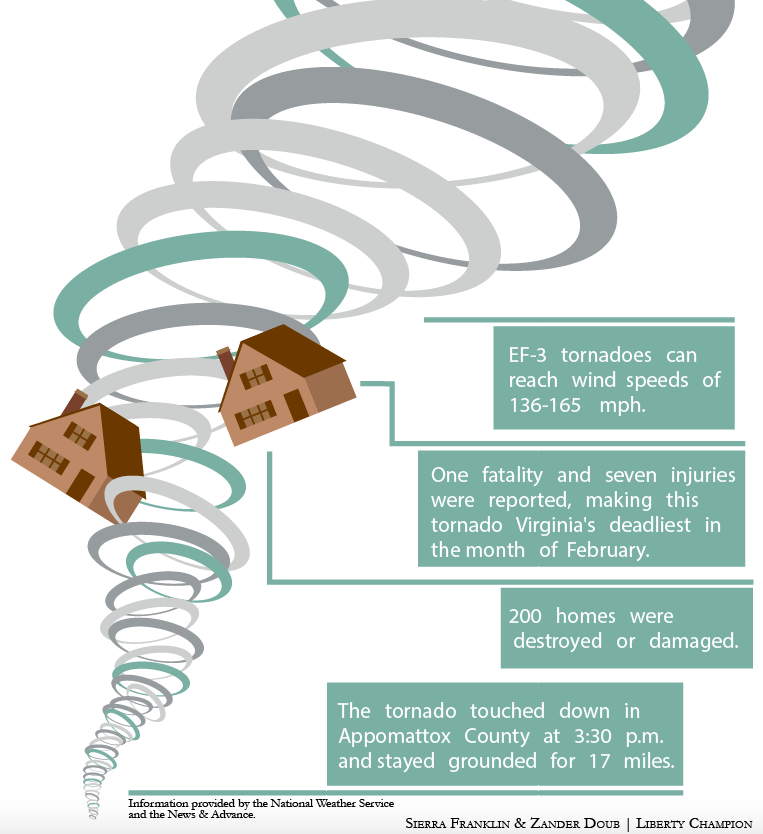Watching the storm develop

Information on how the recent Appomattox tornado developed in size and stature
An EF-3 rated tornado tore through Appomattox County, Virginia Feb. 24. The tornado was traveling at 69 miles per hour and lasted for about 15 minutes on a path that spanned several miles. One person was killed, and seven others were reported injured. According to William Stafford, weekend weather correspondent at WSET, this tornado was an unusually strong one for Virginia, as its winds got up to 165
miles per hour.
“The tornadoes we get here are generally on an EF-0, EF-1, maybe a very weak EF-2,” Stafford said. “We usually don’t see anything in the EF-3 or EF-4 category.”
While a tornado is a largely unpredictable phenomenon until it touches down, there are certain weather conditions which precede tornados and can serve as warnings themselves. As long as these conditions are met, a tornado can happen anywhere at any time.
“Generally you need a bit of moisture in the air,” Stafford said. “You need it to be generally warm, which it was on Wednesday due to the warm front up north. You need a lot of shear, which is the turning of the winds. You also need a good amount of convective available potential energy (CAPE).”
As defined by the National Weather Service’s glossary on its website, convection is the transportation of heat and moisture by the movement of fluid. The higher the convection value, the higher the risk of severe weather like tornadoes. CAPE represents the potential energy available in determining convection levels.
“For this particular instance, we had a high-shear, low-CAPE environment,” Stafford said. “Usually in ‘high-shear, low-CAPE’ or ‘low-shear, high-CAPE’ environments (in Virginia), you get tornadoes that pop up for two seconds and go away. We were not anticipating all of the tornado warnings we got on Wednesday. We definitely weren’t anticipating an EF-3 tornado touching down right in our backyard.”
The best course of action for someone caught in their home or any other building is to get to the lowest level possible. A basement is preferable, but a first-floor bathroom is the next best option.
“Get to the most interior room, away from windows and away from anything that may tear off and hit you,” Stafford said. “Protect your body in any way that you can. If you have a mattress, put the mattress overtop of you.”
Stafford said WSET had reported on a previous tornado survivor who hid in a bathtub with a mattress overtop of him. While the entire home around him had been demolished, the man survived untouched in his bathtub.
For anyone who might be caught driving when a tornado hits, the best option may be a counter-intuitive one for most people.
“You don’t want to outdrive the thing,” Stafford said. “Chances are you’re not going to outrun it. The best thing you can do is get as low as you can. It might seem silly or it might seem like it’s asking for trouble, but you need to get out of your car and take cover in a ditch and protect your body any way you can.”
Stafford urges drivers to avoid being in an underpass during a tornado. A resulting wind tunnel effect in an underpass will suck drivers and their cars back out into the storm. Finding low ground out in the open is the best course of action for drivers caught in such a storm.
For more information, contact WSET’s weather station via email at weather@wset.com.
JARRETT is a news reporter.
